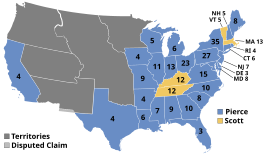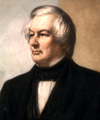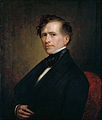Presidential election in the United States 1852
| ‹ 1848 • |
|||||||||||
| 17th presidential election | |||||||||||
| November 2, 1852 | |||||||||||
|
|
|||||||||||
| Democratic Party | |||||||||||
| Franklin Pierce / William R. King | |||||||||||
| electors | 254 | ||||||||||
| be right | 1,607,510 | ||||||||||
|
|
50.8% | ||||||||||
| Whig | |||||||||||
| Winfield Scott / William Graham | |||||||||||
| electors | 42 | ||||||||||
| be right | 1,386,942 | ||||||||||
|
|
43.9% | ||||||||||
| Free soil | |||||||||||
| John P. Hale / George W. Julian | |||||||||||
| electors | 0 | ||||||||||
| be right | 155.210 | ||||||||||
|
|
4.9% | ||||||||||
|
|
|||||||||||
| Election results by state | |||||||||||

|
|||||||||||
|
27 states
Pierce / King |
4 states
Scott / Graham |
||||||||||
|
0
Hale / Juilan |
|||||||||||
|
|
|||||||||||
| President of the United States | |||||||||||
The 1852 presidential election in the United States took place on November 2, 1852 . It was in many ways a repeat of the 1844 election : again a Whig Party politician took over the presidency from his deceased predecessor; in this case, it was Millard Fillmore who succeeded President Zachary Taylor . The Whig Party turned its back on the incumbent at its nomination convention and ran with Winfield Scott . The Democrats set up Franklin Pierce . In their campaign strategy, the Whig relied on the ambiguity in the statements of the Democratic candidate and this strategy failed again.
Franklin Pierce and his candidate for the vice presidency , William R. King , won the election by a clear margin.
Candidates
Whigs
Whig Party Candidates :
The Whig National Convention in Baltimore in 1852 split the party. Supporters of President Fillmore pointed to the successful compromise of 1850 and the failure of an emerging breakaway movement in the Southern States from 1850-1851. The northern Whig believed that the 1850 Compromise favored the slave trade south through the north. The northern Whig supported the Mexican-American War , particularly Winfield Scott of Virginia . Scott was nicknamed "Old Fuss and Feathers" for his military appearance and looks. Most of the New England delegates supported Daniel Webster , which led to a standstill. In the first vote, Fillmore got all but four votes from the south, but only 18. In the first vote, Fillmore got 133, Scott 131 and Webster 29 votes. In the 53rd vote, Scott got 159, Fillmore 112 and Webster 21 votes. In the north, Scott got 142 votes (Fillmore: 11, Webster: 21) and in the south only 11 votes (Fillmore: 142).
William Alexander Graham was elected as a candidate for Vice President.
Democrats
Democratic candidates:
Former Senator Franklin Pierce
Senator Lewis Cass
Ex-Secretary of State James Buchanan
Senator Stephen A. Douglas
The Democrats expected a loss in the general election and could not agree on a candidate. Candidates of 1848 , Lewis Cass , James Buchanan , William L. Marcy and Stephen A. Douglas , each of which had considerable support. In the 49th vote, the assembly finally nominated the relatively unknown Franklin Pierce from New Hampshire as a compromise candidate. William R. King of Alabama was appointed as vice president.
Election campaign and result
The Whigs' electoral platform was little different from that of the Democrats, so the election campaign was more limited to the two candidates. The Whigs thus gave a mixed picture from the outside, as their candidate Winfield Scott opposed slavery , while the party program appeared to be more slavery-friendly. This was facilitated not least by the compromise of 1850 , which was felt to be too slavery-friendly in the northern states, which were predominantly opposed to slavery. However, since the Whigs had their strength primarily in the northern states, this cost them considerable support in the northern parts of the country. Also, compared to 1840 or 1848 , the Whigs found it difficult to highlight Scott's services as a general in the Mexican-American War , as Pierce had such experience.
In the end, Pierce was able to prevail with 50.8 percent of the vote; Scott was 43.9 percent. However, he was only able to obtain a majority of the votes in the states of Kentucky , Tennessee , Vermont and Massachusetts , while Pierce obtained a majority in all of the remaining 27 states. This made his victory in the decisive Electoral College even clearer: 254 against 42. The clear electoral defeat and the division on the slavery question then caused the Whig Party to break up within a few years: Former Whig politicians and opponents of slavery such as Abraham Lincoln formed from 1854 in the Republican Party , advocates converted to Democrats. Others, like Millard Fillmore, joined the short-lived Know-Nothing Party . In the following presidential election in 1856 , the Whigs played practically no role. Remnants of the party stood behind the hopeless candidacy of Fillmore for the Know-Nothing Party. The main electoral battle from then on was between Democrats and Republicans.
Until Franklin D. Roosevelt's election in 1932, it was the last presidential election in which a Democratic candidate won an absolute majority of the vote. All subsequent presidents of the party achieved their election victory only with a relative majority . Samuel J. Tilden won an absolute majority in 1876 , but narrowly lost in the Electoral College.
| candidate | Political party | Popular voices | Electoral votes |
| Franklin Pierce | Democrats | 1,607,510 (50.8%) | 254 |
| Winfield Scott | Whig | 1,386,942 (43.9%) | 42 |
| John P. Hale | Free soil | 155,210 (4.9%) | |
| Daniel Webster † | union | 6,994 (0.2%) | |
| Others | 5,274 (0.2%) |
South Carolina was the only state where electors were not elected by the people but by the state's parliament.
useful information
- The applicants for the office of vice president were both from North Carolina and in fact both attended the University of North Carolina at Chapel Hill , albeit two decades apart. In addition, both offices of this state held: King was a representative in the House of Representatives and Graham was governor .
literature
- Donald Richard Deskins, Hanes Walton, Sherman C. Puckett: Presidential Elections, 1789-2008: County, State, and National Mapping of Election Data. University of Michigan, Ann Arbor 2010, ISBN 978-0-472-11697-3 , pp. 145-154 (= Chapter 19: Franklin Pierce's Election. ).
Web links
- Election results in each state on the side historycentral.com (Engl.)
- Election results in the counties (graphical overview) on the side geoelections.free.fr (Engl.)
- The Convention of the Democrats on the side http://www.ourcampaigns.com/ (Engl.)
- The Convention of the Whigs on the side http://www.ourcampaigns.com (Engl.)
Individual evidence
- ↑ Holman Hamilton: Prologue to Conflict. The Crisis and Compromise of 1850. With a new Introduction by Michael F. Holt. The University Press of Kentucky, Lexington KY 2005, ISBN 0-8131-5831-1 , pp. 186 ff.












